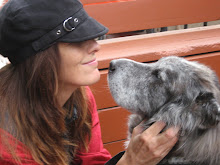





25-08-08
Nairobi, Kenya
My flight from London to Nairobi was smooth. Sleep, oh wonderful sleep, bestowed itself upon me. Lucky for me, I hooked up with principal investigator, Bruce Patterson, his new project assistant, PHD student, Andy Dosmann, and fellow volunteer (NY high school teacher,) Seth Evens in Heathrow. It was great to have the instant bond of our Earthwatch, Lions of Tsavo Team 7 even before arriving.
(Earthwatch is an amazing non-profit organization that sponsors scientific research all over the world. I've been lucky enough to live with the Chamacoco Indians in Paraguay, work with the chimps that use ASL in Washington state, and track grizzlies in the Yukon. For more info on these once in a lifetime experiences, check out their website: http://www.earthwatch.org/expeditions/patterson.html)
The Nairobi airport surprised me. Absolutely calm, orderly, and mellow (it was almost midnight, though.) Right away, I caught the scent of incense wafting through the air. I think I felt different from the moment we landed. Our taxi ride to the Fairview Hotel (a plush plush hotel full of Westerners,) was quick, and interesting, and we passed barricades to protect the Israeli Embassy right across the street. We zigzagged in and around in front, reminding of me of Checkpoint Charlie in Berlin. The hotel itself was beautiful, lush green gardens, waterfalls, pools, gorgeous dark wood architecture. And waking up to an amazing breakfast buffet didn't hurt! There, I met the rest of the group--Kathy from Ohio-a seven year veteran of the Lions of Tsavo project and a greyhound rescuer, Nicola from Wales--a 2 yr. veteran of the project and fellow world traveler, and Susan from Arkansas--mother to 30 rescued parrots and equipment extraordinaire!
A cool and smooth ride to the Rukinga Ranch near Tsavo National Park on the Southern Cross Safari bus. But the passage through Nairobi was profound. Lines of men walking the streets toward the city. Walking toward what? Jobs? Hope? With a 40% unemployment rate, it is a gift to find work in Kenya. And it was hard not to sense the despair of those who went without. The two lanes roads were at times chaotic, no traffic signals. Confusion. Matatus, small van-like buses, packed with people for a more affordable ride. Law now regulates the number of passengers, but the vehicles still overflow with faces smashed up against the glass windows. Colorful head wraps. Innocent eyes. All heading toward another day.
Overhead Marabou storks flew. Nesting in trees. The images of these birds--almost prehistoric in nature-- graced against a struggling urban landscape. I found myself wondering, do we belong? Or do they? My instant reaction to Kenya--specifically Nairobi itself--was of a place of struggle and beauty wrapped into a tapestry of color. A dichotomy of these two forces.
Eventually the traffic calmed (with intermittent construction detours,) and we began our trek out toward Tsavo. The landscape changed from dusty, brown dirt to the rich burnt orange of the earth. And with the change, the land opened up to me, welcoming us into her arms. The arms of Kenya.
Mangoes, potatoes, and onions sold in thatched mud huts--colorful metal curios along the road. The open bed truck in front of me--packed with young men. Some hanging out, all waving and smiling. Small children leading goats and cattle down the road. The African cattle, bony--loose skin dripping off their backs--gravity working hard on the elements. The black and white coats of the goats stark against the sienna backdrop of the land. Women wrapped in rainbow kangas carrying loads and buckets upon their heads. These same women cooking in small open fire pits along the road to provide food for the men who come to eat. The brightness of their kanga cloths a symbol of their strength. Kids running along the road. Contemplating us as we pass by. Their beautiful eyes and genuine smiles in wonder. Or judgement? What do they think of Westerners in their country? In their homes. I am consciously aware of my presence and how I will be interpreted in this place I have dreamed of all my life.
But the open arms of Kenya begin to grasp me further. Massive red termite mounds constructed extravagantly like castles inhabited for up to 100 years. A twiga--giraffe- hidden amongst the browns and oranges of the landscape. An ostrich--tall and alert. A Thompson's gazelle--graceful, striking horns and stripe of white like snow against the blood of the land. Yellow baboons crossing the road, hanging out like casual humans along the bank in acacia trees. What do they think about us as we intrude on their land? Do they see the struggle? The richness? Are they aware of Kenya and her lovely scent? Spicy and sweet and earthy like incense created from the origins of time itself. A smell that fills me up with a sense of wonder and enlightenment--an eternal longing.
With Kenya's gifts, (along with her political, economical, and cultural hardships,) what does the future hold for her? So many steps to walk. So many breaths to take. So many smiles to be given. Regardless of the pain, we breathe in the aliveness together. And from the very first moment, Kenya opens her arms to us.
And willingly we walk forward with love.
Next stop: Camp Tsavo
Lori














































